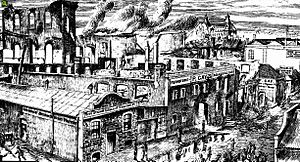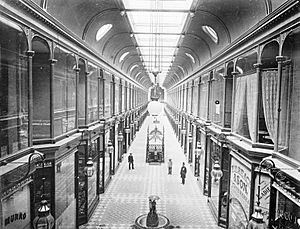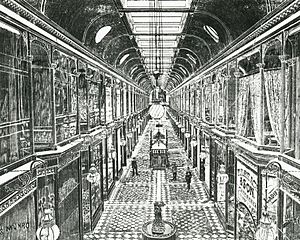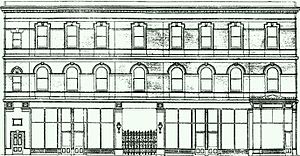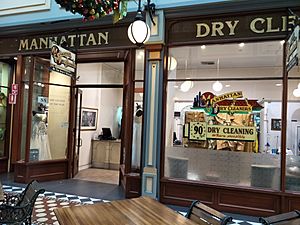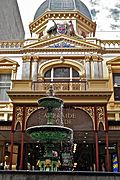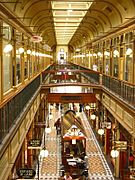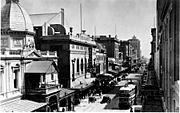Adelaide Arcade facts for kids
The Adelaide Arcade is a historic shopping area in the heart of Adelaide, South Australia. It is connected to another arcade called Gay's Arcade.
Contents
History of the Arcade
The land where the Arcade stands today had two big fires before it was built. The first fire happened in 1855 at a furniture factory owned by George Debney. It destroyed many items and materials.
Patrick Gay took over the furniture business in 1867. He also took over the cabinet-making business next door, which belonged to his father.
By 1880, Gay's warehouse was quite large. It faced Rundle Street and stretched almost to Grenfell Street. The back part of the building, which Gay had made taller, reached Twin Street.
In 1884, another fire completely destroyed the building. It started in the evening, even though the shop had closed hours earlier. People wondered if someone had started the fire on purpose, but there was no proof. Patrick Gay had good relationships with his workers. The insurance money helped him start again, but it didn't cover everything he lost.
Building the Adelaide Arcade
After the fire, a group of business people decided to build a large shopping arcade. This group included Emanuel Cohen, J. M. Wendt, Patrick Gay, Saul Solomon, and L. H. Berens. They wanted to create the biggest shopping arcade in the Southern Hemisphere, connecting Rundle and Grenfell streets. Withall & Wells were chosen as the architects, and W. Pett and Son were the builders.
In 1885, the land for the Arcade was bought. The Arcade would have a wide entrance on Rundle Street and another on Grenfell Street. It also had a path on one side and an entrance to Twin Street on the other.
The Arcade was designed with a wide walkway, about 24 feet across. The floor was made of fancy Carrara marble and black and white tiles in beautiful patterns. There were 44 shops along the arcade, each about 15 feet wide and 24 feet deep, with tall 15-foot ceilings. The shop fronts were made of wood, iron, and large glass panels.
Originally, each shop had a room upstairs that could be used as a workspace. Later, a balcony walkway was added on the upper level. Many of these upstairs rooms then became separate shops. The entrances on Rundle and Grenfell streets were wide and had larger shops on either side.
The outside of the Arcade looked like Italian buildings. The bottom part had glass shop fronts and entrances, covered by verandahs with decorative iron columns. In the middle, there was a square balcony, an octagonal tower, and a dome with an Australian coat-of-arms design.
Inside, the ceiling had wide decorative edges and deep recessed panels. These panels had colored glass, letting in extra sunlight. The Arcade also had special systems for lighting and fresh air.
At night, the Arcade was lit by sixteen Siemens arc lamps. These were very modern for the time. The power for these lights came from a special gas engine located in a separate room. This was only four years after a similar system was first used in Godalming, England. Gas lamps were also placed outside each shop in case the electric lights failed.
The Arcade also featured three fountains and an underground tea-room. There were also plenty of restrooms for visitors. The builders used local materials as much as possible, including two million bricks from the Metropolitan Brick Company.
The building project cost over £30,000. Construction began on 29 April 1885, and the foundation stone was laid on 6 May 1885. The Arcade officially opened on 12 December 1885, by Governor Sir William Robinson. It was almost finished by the planned date, but some imported parts arrived late. A huge amount of glass was used – about 50,000 square feet!
The Arcade was built during a time when the economy was not doing well. It was hard to find people to rent the shops. To encourage tenants, a year of free rent was offered. Because the Arcade wasn't making much money, the original owners slowly sold their shares to Wendt. By 1906, Wendt owned the entire Arcade.
Gay's Arcade
While the Adelaide Arcade was being built, another connected project began: a smaller arcade called Gay's Arcade. It would connect Twin Street to the Adelaide Arcade.
In August 1885, a different architect, James Cumming, and builder, Nicholas Wallis Trudgen, were hired for Gay's Arcade.
Gay's Arcade was designed to have a 100-foot front on Twin Street and stretch 119 feet to the Adelaide Arcade. The building on Twin Street would have three floors, plus cellars. It would have five shops on the ground floor, with Gay's furniture store and workshops on the two upper floors. The passage through this building would open into a two-story arcade with twelve shops. These shops would have carved wooden frames and large glass windows, similar to the Adelaide Arcade.
The roof of Gay's Arcade was made of glass and metal, with good ventilation. The walkway was paved with tiles and marble. While the main Adelaide Arcade used electric arc-lamps, Gay's Arcade used newer "Wenham" gas-lights. This focus on good lighting was important, especially for shops selling fabrics. Gay used the two upper floors of the main building and one side of the arcade. The shops also had back entrances and good natural light.
Later History of the Arcades
After Wendt passed away, his family sold the Adelaide Arcade to two Adelaide business owners, T. E. Crompton and a Mr. Simpson.
Later, these gentlemen sold it to a group that included Charles Angel, Angus Scott, and Captain Johann George Arnold.
In the 1960s, a balcony area was added to the arcade, increasing the number of shops to over 100.
On 3 August 1980, a fire broke out in Gay's Arcade, causing a lot of damage. Smoke and other damage also affected Adelaide Arcade, which had to close for over a week.
The Adelaide Arcade was listed on the Register of the National Estate in 1980, and on the South Australian Heritage Register in 1985. These listings help protect its historical importance.
Hauntings
Many people say the Adelaide Arcade is haunted. A TV show called Haunting: Australia even did an official investigation there in 2013. The show featured a local historian who studies paranormal events, Allen Tiller.
Francis Cluney
Francis Cluney was an early caretaker of the Arcade. He died in the engine room on 21 June 1887. He got caught in one of the large flywheels of the gas engine that powered the lights. Cluney had been told to watch the machinery but not to touch it. It's thought he might have slipped on the floor, which could have been slippery. The engine room is now a dry cleaner's shop.
Some people say that his death was caused by two unruly locals who pushed him into the generator. His ghost was supposedly caught on security camera footage in 2008. Footsteps and strange sounds have also been heard in the ceiling, on the rooftop, and in the dome of the arcade. Many believe these are signs of Francis Cluney.
Florence Horton
Shop 50 in the arcade is said to be haunted by the ghost of Florence Horton. She was a local woman who was shot by her estranged husband on 27 February 1904. Florence was carried into a tobacconist shop, which is now Koko Black/Shop 50, where she sadly died.
Sydney Kennedy Byron
Three-year-old Sydney Kennedy Byron died in the Regent Arcade, near the Adelaide Arcade, in January 1902. Sydney's mother, Bridget Lauretta Kennedy Byron, also known as 'Madame Kennedy', was a palm reader who worked in a shop in the Adelaide Arcade. She was accused of causing her son's death but was found not guilty. She died six months later. The ghosts of Sydney and Bridget are said to haunt the alley between the Regent and Adelaide Arcades.
Gallery
Other Arcades in Australia
The Adelaide Arcade was not the first of its kind in Australia. Before 1885, Melbourne had several arcades, including the Queen's Arcade (1853), Victoria Arcade (1854), Royal Arcade (1870), and Eastern Arcade (1874). Sydney also had the Royal Arcade (1881) and the Sydney Arcade (1882).
Melbourne's Royal Arcade holds the record for being open continuously for the longest time.




